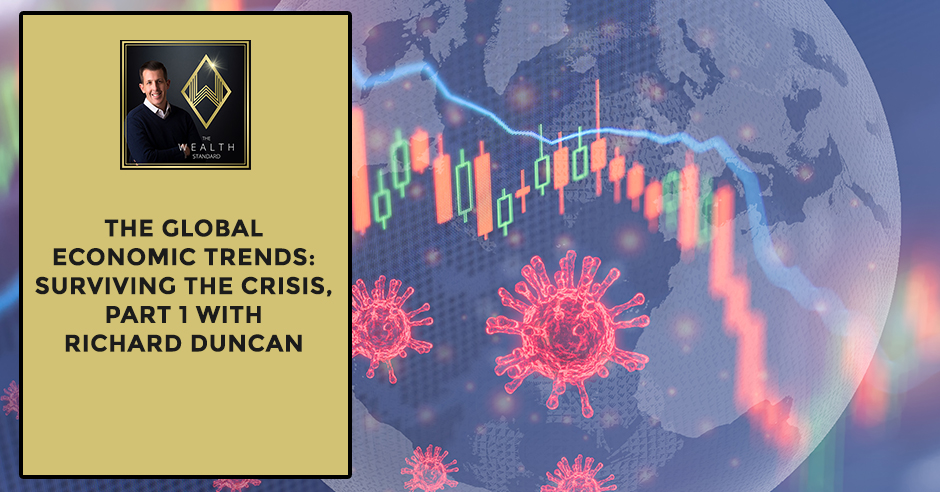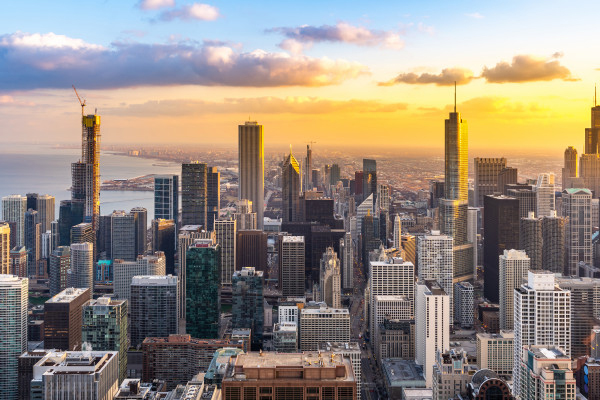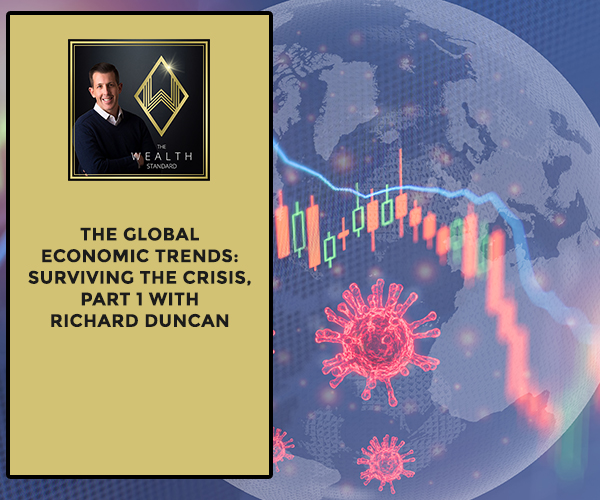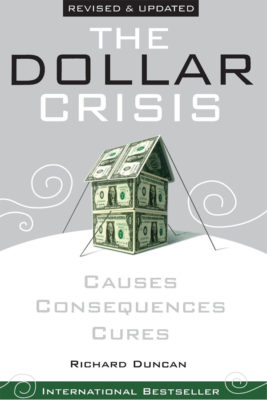The Global Economic Trends: Surviving The Crisis, Part 1 With Richard Duncan

The current crisis involving the COVID-19 pandemic has got a lot of people wondering what’s going on with the global economy and what is likely to come in the subsequent months, years, and so forth. It is no secret that things are happening around the world from a monetary and fiscal standpoint that most people aren’t aware of. However, studying them is ultimately going to position you to take the most advantage of not just this environment, but future environments as well. On today’s show, Patrick Donohoe is joined by a professional economist and the publisher of the video-newsletter called Macro Watch, Richard Duncan. Richard talks about what’s going on in the economy and the importance of knowing what the future looks like and what things to pay attention to so that you can adapt and ultimately know what’s coming.
Get a 50% discount off a Macro Watch subscription by visiting https://www.richardduncaneconomics.com. Hit the subscribe button and use the discount coupon code: June
Watch the episode here:
Listen to the podcast here:
The Global Economic Trends: Surviving The Crisis, Part 1 With Richard Duncan
This is going to be part one of a two-part series. There is much to talk about with Richard Duncan and extract from him his perspective on the economy. What is going on from the Federal Reserve’s and the Central Bank’s standpoint? Ultimately, what is to come? Before I get to the introduction for Richard as well as setting the stage for both parts of the interview, I wanted to tell you about a couple of things. First, a good friend of mine, Mike Dillard, many of you may know who he is. He has a popular podcast and he’s one of the best online business people I know, an incredible marketer. Mike has put together an opportunity. Mike has worked tirelessly to put together a community for the purpose of helping the business and the entrepreneur world, to understand what’s going on and to take advantage of the opportunity because the professional world is changing. The business world is changing.
He’s put together this community of experts when it comes to consulting, online business, digital business. This opportunity is essentially a community, where you can learn from some incredible minds about what to do. What are some of the opportunities? What are the first steps? What are the second steps? It’s an incredible opportunity. It’s in line with a lot of what was spoken about in the last seasons of The Wealth Standard Podcast. Go check that out at TheWealthStandard.com. Every episode has a video associated with it. Head over to YouTube and subscribe. That would mean a lot to me and you can watch the videos as opposed to listening to them. All the interviews are being videoed and all past interviews are on there as well. Finally, the editors I have are incredible and we have lots of written content that we’re going to be distributing. Make sure you’re a part of our newsletter. Most of it will be announcements associated, whether it’s the Mike Dillard opportunity or other things that I’m paying attention to, as well as new episodes of the show. Make sure you head over to TheWealthStandard.com and check that out.
Let me introduce Richard. He’s the author of three books, The Corruption of Capitalism, The New Depression and The Dollar Crisis. All these books were written around 2010 to 2012 mark. Richard is a Professional Economist. He lives in Thailand. He’s gracious enough to give us this time. Richard, full-time he does what’s called Macro Watch. Go ahead over to RichardDuncanEconomics.com and you can subscribe to that. Readers of the blog get 50% off. It’s $500 for a yearly membership, so it’s $250. What he puts on there are these snippets and video analysis of what’s going on in the economy. They’re fascinating and he does it within 10 to 15 minutes, which is even more indicative of how brilliant he is by being able to chunk deep information into that short of a piece. Richard understands the economy from not a philosophical perspective. There are lots of different schools of economics. Richard looks at things as how they are.
Our monetary system operates a certain way. Although there are many that wish it was a different way and put faults on how it is based on how it should be, the fact is, it isn’t. Our monetary system is a certain way. What is occurring with the influence of the Central Bank, specifically the Federal Reserve in the United States, will most likely always have a primary role when it comes to influencing whether it’s trade, government, the global nature of the economy. It’s always going to have a role. Understanding what it is and then subsequently what signals and things to pay attention to so that you can position yourself, whether it’s from an investment standpoint or a personal standpoint with regards to business. How can you position yourself to take advantage of the situation based on what it is, not based on what it should be?
Let me give you a little bit of his background. He started in Asia in the late ’80s as the Global Head of Investment Strategy at ABN AMRO Asset Management. He worked in the financial sector specifically as a specialist at the World Bank. He headed equity research for Solomon Brothers in Bangkok. He’s also worked as a consultant to the IMF, International Monetary Fund, in Thailand during the Asia crisis. He does full-time Macro Watch, which is a video-based newsletter. This is Robert Kiyosaki’s favorite economist. He has been one of the Keynote people on The Cash Flow Wealth Summit that we’ve put on over a couple of years. It has some insights that you’re going to want to pay attention as to as to how things are leading up to the crisis and then what’s going on amidst the crisis? What is likely to come in the subsequent months, this 2020, 2021 and so forth?
If the government uses all of its firepower as it would in any other war, we can come out of the other side winning this crisis. Click To TweetFor me, I believe that there has been a significant impact to the psychology of people, to the economy, to markets. What’s going on is that the world, the economy, the society is never going to be the same as it was. Looking at what is happening will help you to know what the future looks like and what signals and things to pay attention to so that you can adapt and ultimately know what’s coming. In the end, we can’t control monetary policy. We can’t control what this body does or what this person does or what philosophy they should subscribe to. The fact is, things are happening around the world from a monetary and fiscal standpoint that most people aren’t aware of. Becoming familiar, studying them is ultimately going to position you to take the most advantage of not just this environment, but future environments as well. Without further delay, let’s cut to the first part of my interview with economist, Richard Duncan.
—
I have Richard Duncan on with me and he is in Thailand. We made this work and I’m excited about this conversation. Richard, thank you for taking the time.
Patrick, it’s my pleasure. Thank you.
I thought the best way to start is to form a context, so that the readers can know where you’re coming from. As we start to talk about what’s going on and what is potentially going to occur in the future and what to look for, it’s important to know where your perspective is. We’ve been talking about your qualifications. Also, describe what has been the evolution of monetary policy from maybe the Federal Reserve and where we’re at.
I was born and grew up in Kentucky. I went to Vanderbilt. I ended up backpacking around the world after college. I was lucky I got to see Thailand, Malaysia and Singapore in early 1984 and it was booming economically. I realized, “Go East, young man.” I went back to business school for a couple of years at Babson College, and then I flew to Hong Kong and found a job in 1986 as a Securities Analyst working for a local Hong Kong Chinese stockbroking company. I’ve spent almost all of my career working in Asia first as an equities analyst and economist and strategist, managed large research departments for what’s now HSBC Securities and Solomon Brothers in Thailand. I worked for a couple of years at the World Bank in Washington during the Asia crisis as a Financial Sector Specialist.
In 2005 and 2006, I was in London as the Global Head of Investment Strategy or ABN AMRO Asset Management, looking at all the asset classes globally. I’ve written three books along the way. The first was The Dollar Crisis, which I believe did forecasts the crisis of 2008 accurately. I’ve been lucky to live in Asia most of this time and because for many reasons, Asia has had such extraordinary economic growth most of this period. One of the first things I realized when I started working in Asia and saw all of the factories around Southern China full of young women working for less than $5 a day, that these global imbalances were going to completely destabilize the world. They industrialized the US. They were extremely deflationary at least in the direction of disinflation deflation. The rise of China and the global implications of that geopolitically, but also economically the consequences of the enormous trade imbalances and how they are financed. That’s my background.
I produce a video newsletter called Macro Watch. The way it’s useful to understand the world from the macro perspective is this. You can think of the global economy and all of the assets, classes, stocks, bonds, property, all of that is floating on an ocean of credit and credit growth drives economic growth. It’s been that way for many decades. In the US since 1950, there were nine times between 1950 and 2009 when total credit grew by less than 2% adjusted for inflation. Every time credit grew by less than 2%, the US went into a recession and the recession didn’t end until there was another big surge of credit expansion. What do I mean by total credit? The total credit is equal to total debt. You can think about this as all the debt, government debt, household sector debt, corporate debt, financial sector debt. Debt growth drives economic growth. The same thing as credit growth drives economic growth.
In 2008, the private sector couldn’t continue servicing the interest on all of the debt and total credit started to contract when we started going into a depression. The government responded with massive budget deficits, more than a trillion dollars a year for four years in a row. The Fed monetized a third of those budget deficits with three rounds of quantitative easing. Since 2008 credit growth has been barely above the 2% recession threshold as I call it. It hasn’t been enough to drive the economy. The Fed has had to step in and push up asset prices with low-interest rates and what was four rounds of quantitative easing before this crisis started, the fourth having started with the repo problems. They pushed up the stock market and that created a drove up American household sector net worth to extraordinarily high levels and that wealth effect supplemented the credit growth and was sufficient in combination to make the economy keep growing. Although it wasn’t growing rapidly, it was growing.

Global Economic Trends: If the US would go into depression, that alone would be enough to grow the global economy into a depression.
Credit growth drives economic growth and when it’s not high enough, the Fed tries to intervene to push up asset prices and supplement the credit growth with asset price inflation. In other words, the government is managing the economy at the macro level. This has been going on at least since 1941 when World War II started. At that time during World War II, government spending increased by five times in four years. The Fed’s holdings of government securities increased by eleven times reflecting how much money the Fed created to help finance the war. That increased in government debt and paper money creation during such a short period of time. That investment that occurred by the government created new technologies and set off a two-decade-long economic boom in the US that circle much of the world.
The government has been managing the economy at the macro level one way or the other, sometimes better and sometimes worse since then. In order to understand what’s likely to happen with the markets, it’s important as a starting point to understand that the government is trying to manage this and to try to anticipate what they’re going to do next and make a lot of speeches. They tell you what they’re going to try to do next. If you listen to what they’re saying, that provides a lot of help in terms of understanding what’s likely to occur next. Once this virus started impacting the United States and the stock market started dropping, I’ve done five Macro Watch videos on this subject and one was called Recession or Depression?.
That was before people started calling this a depression and before the Fed launched Quantitative Easing Infinity before these $1 trillion government bills to support the economy. By that point, it was clear to me that if the stock market started falling 20%, 25%, the Fed would take radical action to try to drive the stock prices back up. They understand that the asset price inflation is the thing that’s keeping the US out of a severe recession. They weren’t going to sit back and let the stock market crash by 50%, which it would have without government intervention. More than 50% I’m sure, it was expensive to start with. By understanding this framework that how the government manages the economy, it does provide a lot of insight and what’s likely to happen next in terms of movements in the markets.
When all this occurred, it didn’t surprise you when markets started to be disruptive, especially early on when the Fed came to the rescue and you saw these stimulus bills being proposed, whether it was the early ones with regard to funding healthcare and those different organizations and to small businesses. That didn’t surprise you?
No. I’m glad that they did. It wasn’t certain that the government would do that because Congress is quite messy. You don’t know for sure what the government is going to do at the congressional level. It’s easier to predict what the Fed is going to do because it’s controlled by far fewer people. You understand the situation much more clearly than all of the Congressman and Senators. You can never be entirely certain what Congress is going to do. In that video I called Recession or Depression, my point was this. Whether or not we have a recession or depression, it’s going to depend entirely on the speed and the size of the government’s policy response in terms of the size of the fiscal stimulus and the size of the monetary stimulus. Luckily, the government did respond quite quickly on both fronts. Not too much later than that, the Fed announced QE Infinity.
It’s what people are calling it. Buying limitless amounts of government bonds or as much as it required. Congress passed the $2.2 trillion Rescue Bill, which they are popping up with another $500 billion. That was a good step in the right direction. That was a down payment. They did it quickly and that’s the reason that we’re not in a great depression. Have they not have done that, all of the US banks would be in the process of failing and the majority probably of the small and medium-size businesses as well as the majority of the US corporations would also be in the process of failing. Unemployment would be surging up to 30% if not 50%. This government response has kept us out of a great depression so far. Hopefully, they’re going to continue doing more of this because in this crisis, there is no sensible alternative.
If they were to step back and do nothing, then the government debt would explode anyway because the economy would collapse. All the government tax revenues would disappear and the mandatory payments through things like Social Security and Medicare and unemployment insurance would explode. The budget deficit would become enormously large anyway and we wouldn’t have an economy. That doesn’t make any sense. It’s far better for them to do what they’re doing and keep government spending, sending out checks to individuals and propping up small and medium-sized businesses. Also, propping up corporations in the banks because the alternative is complete open-ended depression with no end in sight. Who knows what social geopolitical consequences are?
The government's debt effectively tripled between 2008 and now. That was necessary to keep the economy growing. Click To TweetThat was the other point too, which accelerates it and magnifies the severity is that everything’s global. If something’s done here and in order to create the balance as it relates to the global economy, it’s going to be done worldwide. Let’s say the government did use Laissez-faire policy and didn’t do anything, it wouldn’t impact the United States. It would impact the world.
The US would go into depression and that alone would be enough to throw the global economy into a depression, even if they tried to respond aggressively with their own fiscal and monetary policies as they are doing to the best of their abilities.
Looking at the scope of this, we’re already probably approaching $3 trillion, almost $4 trillion in the stimulus. That’s in 1.5 months, almost two months. How much larger it is than what occurred during 2008, 2009? In your estimation, how much can the government stimulate? There hasn’t been much productivity at all in many different sectors, which tells me that the ripple effect it’s going to last for a long time. Does the government have enough firepower to be able to support this massive shock to the system?
We’re fortunate that the United States is a wealthy country. It does have the firepower. If the government uses all of its firepower as it would in any other war, we can win this war and come out the other side being quite similar to a country we were when we went into this crisis. If we don’t, we will lose the war and who knows what the country would look like or the world in that case. For example, the US economy in 2019, the GDP was about $21 trillion in size and the government’s debt to GDP was somewhere around let’s call it 110%. For an extreme example, if the government had to spend $21 trillion propping up the economy over the next couple of years, then that would cause the government debt to GDP to double to 220% GDP. That’s below where Japan’s government debt to GDP is. Japan has more than 250% government debt to GDP and they don’t have double-digit interest rates. Their interest rates are zero. They don’t have hyperinflation. They have very mild inflation and sometimes deflation.
The government at the fiscal level has enormous firepower and they need to use it. It’s going to be expensive. It’s certainly going to cost $5 trillion. It looks like at least, maybe $10 trillion. If it does, then so be it. That’s the price we’re going to have to pay and luckily, we can afford it. The Fed can help finance this by what it’s doing now. The Fed has created $2.1 trillion that has increased the size of their assets, which reflects how much money they create. That has increased the size of their total assets by 48%. They’re going to have to continue creating much more money to finance the large government budget deficits ahead. During the crisis of 2008, between 2008 and 2014 when the third round of quantitative easing ended, the Fed’s total assets increased by five times from $900 billion at the end of 2007 to $4.5 trillion. It’s a fivefold increase. In the Fed’s first 90 years or so, it created $900 billion. They increase that by fivefold over the next seven years.
If the Fed were to increase this balance sheet fivefold this time from where it was when this crisis started, that would give them an additional of almost $17 trillion of firepower to buy government bonds and to support the economy in various other ways through making loans as it’s doing through its Alphabet Soup lending facilities. This launched inject credit into every corner of the economy. We have enormous firepower. The question is though, will all of this eventually lead to high rates of inflation? The government’s debt effectively tripled between 2008 and now. That was necessary to keep the economy growing. As I said, the Fed’s balance sheet increased by five times. That didn’t cause any significant inflation at the consumer price level in the United States.
There were assets that were inflated. That’s where it affected, but not from a consumer price standpoint.
The created asset price inflation but that was part of the objective to push up asset prices to create a wealth effect. That helped drive the economy and generate the economic growth that we’ve had. Although, it did increase income inequality. Certainly, it wasn’t ideal in that respect, but it was necessary. It’s hard to see what other alternatives there were other than collapse. This time, are we going to have inflation? Of course, it depends on how long the virus lasts and how much the government does increase debt and how much new money the Fed does create. The answer to this question is going to depend on whether globalization persists or not. One of the most important things that have occurred more or less during my lifetime is that we’ve moved from a gold-backed monetary system, which prevented the Central Bank from creating large amounts of new money. Up until 1968 or the Fed was required to own gold to back the Federal Reserve Notes, the dollars that it created.

Global Economic Trends: We need to be careful before we accuse people without knowing the facts. We need to maintain relations with all the countries.
That only ended in 1968 and then the old regime ended up entirely in 1971 with the breakdown of Bretton Woods. Afterward, there were no limits on how much money the Fed could create except the fear that it would cause inflation as large increases in money printing has always done in the past. Starting in the 1980s, the US started running large budget trade deficits with the rest of the world. It started rather than only buying things in Michigan, in Pennsylvania, in New York State, having everything made in the United States with US Labor as we had done up until then, we started buying things from other countries and started running large trade deficits. Before long we started buying lots and lots of things from countries with low wages and this was extremely deflationary.
These deflationary pressures from our enormous trade deficits and globalization, they offset the inflationary pressures that would normally result from large budget deficits and lots of paper money creation. This combination of no longer having to back the money with gold and globalization combined have created a completely new paradigm in which it has been possible for instance over the years with the government to triple its debt and for the Fed to expand his balance sheet what was five times in seven years without creating any inflation at all at the consumer price level. Globalization is the key. If globalization breaks down, this paradigm will collapse and we will move back into the world of the 1960s and ’70s where budget deficits and paper money creation lead down double-digit inflation and high interest rate.
If globalization persists, and it’s possible that the Fed could expand its asset size by another five times creating another $17 trillion or so of new money without creating significant rates of inflation. The trillion-dollar question is, “Will globalization survive or will it not survive?” This is not at all certain, even before the virus broke out. We were more or less in a Cold War with China. I would say relations have deteriorated sharply since then. Also, we had trade tariffs on China before this started. They were supported by both parties, by the Republicans and the Democrats. There was a visible change in our attitude toward our relation with China, whether or not we wanted to continue it on along the same lines that we had pursued for a number of decades.
Where do you stand now? It’s become much more political and I would even say social because there is a lot of finger-pointing happening. When China shut down, that shuts down the supply chain and they’ve been targeted and called hoarders. They wouldn’t release the stuff that continued to be manufactured through the world supply chain. Do you think that the chance of maintaining globalization is up or do you think it was strong enough where it could survive something like this, including the societal blowback?
Regarding China, it’s important that we keep a balanced view. On the one hand, Americans have realized that we were not able to produce enough surgical masks and ventilators or even medicine that we need and had to import it. Hopefully, surely this is going to result in some significant reindustrialization of the United States and some onshoring of many products that we had previously imported. That is a necessary thing and a good thing. On the other hand, we have to be careful not to go too far in this blame game with China, heating up the political rhetoric, turning China into an enemy and trying to blame them for all of our problems. There have been lots of rumors going around about where the virus came from and was it created in a lab. I don’t know what happened, but I was in Hong Kong during SARS and no one has said that came out of a lab.
There have been plagues sweeping this humanity for thousands of years. They didn’t come out of military labs. We’ve needed to be careful before we accuse people without knowing the facts. Even if it did escape from some lab, that doesn’t mean they did it on purpose. We need to maintain relations with all the countries in the world and China is a large competitor and partner in some senses. We don’t want to have another all-out World War as we did with the Soviet Union and move back into a stage where the world fragments in two competing blocks. I like living in Asia. Asia would likely, at least land-based Asia from Eastern China to somewhere not too far away from Europe, would come under Chinese control if push comes to shove.
The history of the world teaches that countries with superior technology don't treat inferiors timely most of the time. Click To TweetThat’s not what we want to happen and that doesn’t have to happen. We can maintain our relations with China, but we have to be smart about it. The United States wants this virus, the crisis passes. The United States needs to understand that China is going to overtake the United States economically, technologically and militarily within the next 1 to 2 decades if trends continue. China invests so much more than the United States does. China overtook the United States in research and development for the first time. If trends continue by the end of this decade, they will be investing 40% more a year than the United States is. China’s already won the 5G race. If they win the AI race, the way they have won to 5G race, then it would be the 21st’s artificial intelligence. It would be the 21st century equivalent of China having a nuclear monopoly.
The quantum computing or computing race. Richard, you should go into this a little bit more and could you distinguish between how the Central Bank of the United States, the Federal Reserve as stimulated business through low-interest rates? I would say also, as businesses have the ability to issue bonds, issue credit and buyback stock. For me, how I look at it is there hasn’t been a push as to what businesses should do in the United States with the stimulus, low-interest rates and so forth. In China, it’s more intentional where they create a stimulus, but they direct the stimulus in certain areas, mainly toward the end of innovation. That’s what you’re referring to. Am I getting that right? Could you maybe explain your take on what stimulus means to US-based companies versus what stimulus means to Chinese companies?
Public opinion in the United States and probably all countries swings back and forth over the decades. They tend to swing too far in one direction and then a few decades later it’s swung too far in the other direction. During World War II, the United States Government took over complete control of the economy, took over production, manufacturing, distribution prices and labor. They drafted people and sent them off to war to die. It was complete government control over the economy. We don’t want that. In 1957, the Soviet Union sent out Sputnik and this sent off the United States into a panic. The first satellite and the US government responded by investing much more money in research and development and science. The level of government investment than in the ‘60s was high and in the United States, and as a result, we won the space race. We sent a man to the moon.
Even under President Reagan had the government invest so much in the US military that the Soviet Union couldn’t keep up. Between all of this investment in rockets during NASA, which helped us develop Intercontinental ballistic missiles that Russia couldn’t afford, we bankrupted the Soviet Union through government investment. Since that time, the sentiment has swung in part because of President Reagan’s rhetoric that the government is the problem. Everyone bought into that and thought government, it was the problem. The government-level of investment has been rolled back to such a small level that we are lagging behind. This 5G should be recognized as our new Sputnik moment because if China gets artificial intelligence before we do artificial general intelligence where their AI can do anything that humans can do, from there it increases exponentially. They will have the rest of the world, including us at their mercy.
I’m not an anti-Chinese, but I want us to be there first. The history of the world teaches that countries with superior technology don’t treat inferiors kindly most of the time. We don’t want to be in a position where we will be a vulnerable second-rate power twenty years from now, which we will be if we do not radically change our approach toward government investment in new industries and technologies. There’s no reason that we can’t afford to do this. I’ve been working on my new fourth book for quite a long time and it’s about ready to go. One of the main themes of this book was that over the next ten years, the United States government must invest trillions of dollars in the industries of the future such as artificial intelligence, neural sciences, genetic engineering, biotech, nanotech and robotics. The Fed could finance a good part of that. I argued both cases. I didn’t put a specific total amount on it, but I used an example of $10 trillion.
The interest rates are the cost of renting money. It depends on supply and demand. Click To TweetIf the US invested $10 trillion more than they plan to at the moment, over the next ten years, then we could easily afford that. That would only have taken US government debt up to less than 100% in 50% of GDP. If every last cent to that $10 trillion was totally wasted, we contributed nothing whatsoever. In the worst-case scenario, we would’ve had a debt level that Japan had many years ago. The other case is the Fed could have financed the whole thing by creating money and buying all the government debt and then it would have been free. That was my theme. That would have been over $10 trillion over ten years. Suddenly the world has changed, which is going to require another chapter to my book. Instead of $10 trillion over ten years, we’re going to have $3 trillion if not $5 trillion in 2020 over the next twelve months. That’s going to be an extraordinary unprecedented economic experiment.
If we come out of this with an extra, let’s say $5 trillion of government debt with the Fed having printed an extra $500 trillion and we don’t have high rates of inflation, what’s the lesson we need to learn from this? The lesson is if we can do $5 trillion over a couple of years, we can certainly do $10 trillion over ten years. For instance, the National Cancer Institute, its annual budget is $6 billion a year. That is the main agency for the US government to invest a cure in cancer. Cancer kills 600,000 Americans every year. How about trying $60 billion a year or $600 billion a year? My point is $1 trillion is a whole lot of money. If we have an investment program of that size and we can cure all the diseases, we can expand life expectancy by decades. We can improve human happiness and wellbeing enormously, as well as economic prosperity not only within the US but it would spill over around the world.
Not in consequently, we could also maintain our global preeminence and our National Security and not be overtaken by China, which has a plan to beat us in all these areas which they’re doing. It’s going to be interesting to see what happens when we come out of the other side of this virus, how much debt we have? How large is the Fed’s balance sheet and how high is the inflation rate? There’s never been an experiment like this in economics before other than World War II, which we won with massive government debt and massive paper money creation. All of that investment during World War II led to a twenty-year economic boom in the United States. We’ve maintained our preeminence for 75 years as a result of that victory, which was government-directed and finance.

Global Economic Trends: If we want to have higher interest rates, then the government can orchestrate that by borrowing more money and hopefully investing it.
I’m not sure how to articulate this, but going this direction, what are the unintended consequences of our monetary policy? Clearly, there are benefits. I still believe that low-interest rates create the idea of innovation. Businesses can use money and credit to expand. I know that there’s been lax in the standards of raising capital in the US mainly because a lot of the Silicon Valley and other areas in the US that have a high concentration of startups, innovation and technology going on in all of the different sectors that you’ve mentioned. That’s one way to do it. If we go even further where you have more capital and more investment, more capital credit available for people, what are the unintended consequences of that? In Japan, they have, I believe negative interest rates or close to negative interest rates. At what point did the US get to that point and do negative interest rates or low-interest rates negatively impact certain things that would be collateral damage of this type of initiative?
Before coming to the possibility of negative interest rates, talking of negative consequences in general, people are influenced by the brilliant economists of the past. In the past, creating a lot of money and having large budget deficits led to inflation and high-interest rates. That was undesirable. That was the main negative consequence that everyone fears and is in everyone’s mind, not far in the back of their mind, pretty much in the front of their mind. This is going to lead to inflation, but it hasn’t. Things have changed because of globalization as I was saying. That was the main reason we never did this before and the main reason that we haven’t tried it yet because everyone is afraid of the inflationary consequences. That’s the main word. If the globalization breaks down, then that will reassert itself that will reoccur if we return to having a closed domestic economy without trade deficits. In terms of negative interest rates, it’s unlikely the US won’t have negative interest rates.
Even at these high levels of debt?
The interest rates are the cost of renting money. It depends on supply and demand. In the past, it only used to depend on the demand for borrowing money because the supply was gold and it was roughly fixed, simplifying matters a bit. If the government demand for money increased a lot and it pushed up the cost of renting money, it pushed up interest rates. We also can control the supply of money to do the paper money creation. If the government borrows $10 trillion and the Fed prints $10 trillion, then there should be no change in the cost of renting money. If the government wants interest rates to go higher, they can borrow $15 trillion and have the Fed print $10 trillion. The demand will be higher than the supply and interest rates will go up. Those are extreme examples. I’m not suggesting that do $10 trillion or $15 trillion. To illustrate demand and supply factors, the government should be able to control the level of interest depending on the amount it borrows relatively to the amount of money the Fed creates.
Not necessarily in this context, but this is yield curve control where the government or the Central Bank controls the level of interest rates all along the yield curve depending on how much money they create and which type of government bonds they buy. In Japan, the Bank of Japan used to have a fixed amount of money that it announced it would create every year. It’s quantitative easing program. They realized that they didn’t have to create that much money to hold interest rates, that put us back to 0. That’s ten basis points. They create as much money as necessary to hold the ten-year Japanese government bond, that ten basis points, whatever amount of money that is. The governments can hold the interest rates at any level they choose depending on the balance between government borrowing and central bank money creation, buying those bonds.
All of the investment during World War ll led to a twenty-year economic boom in the United States. Click To TweetThere are regulated institutions, even Social Security that buy zero non-marketable government bonds and treasuries. If it’s at a 0% interest rate, there’s no income coming off of that. There’s no income coming off of it unless it’s this massive amount of money. How do you have certain sectors, whether it’s pensions or insurance companies or other interest-sensitive type of setups? Is there a negative impact to them?
What we saw as this virus started heating up in the US was interest rates crashed long before the Fed cut interest rates. Market drove up interest rates lower, not the Fed because everyone sold their stocks and bought bonds and pushed bond prices up, which drives bond yields down. The collapse in interest rates was a market-driven process. The Fed followed the market and eventually raised to zero. They were not the ten-year bond yield, a low of 38 basis points? That was market-driven. If we want to have higher interest rates, then the government can orchestrate that by borrowing more money and hopefully investing it.
Right now, they’re borrowing it and giving people money so they won’t go hungry. They would continue to pay their rents and their mortgages, which is the right thing to do. In future years, if interest rates are too low, the government can borrow more and push interest rates higher and use that borrowed money to invest in the industries of the future and induce a new technological revolution that will massively enhance US productivity and enable us to maintain our leading role in the world and maintaining National Security.
I like where your stance is there. We’re at a point where we’re in a debt-based society. It comes down to how it’s directed and how you use it to influence. In looking at what’s going on in the response, it’s the only way for the government to respond.
Important Links:
- Richard Duncan
- Mike Dillard
- YouTube – The Wealth Standard
- The Corruption of Capitalism
- The New Depression
- The Dollar Crisis
- Macro Watch
- Cash Flow Wealth Summit
- Recession or Depression?
- http://www.RichardDuncanEconomics.com/
About Richard Duncan
 Richard Duncan is the author of three books on the global economic crisis, including the international bestseller “The Dollar Crisis: Causes, Consequences, Cures,” which forecast the global economic crisis of 2008 with extraordinary accuracy.
Richard Duncan is the author of three books on the global economic crisis, including the international bestseller “The Dollar Crisis: Causes, Consequences, Cures,” which forecast the global economic crisis of 2008 with extraordinary accuracy.
Since beginning his career as an equities analyst in Hong Kong in 1986, Richard has served as global head of investment strategy at ABN AMRO Asset Management in London, worked as a financial sector specialist for the World Bank in Washington D.C., and headed equity research departments for James Capel Securities and Salomon Brothers in Bangkok. He also worked as a consultant for the IMF in Thailand during the Asia Crisis.
He is now the publisher of the video-newsletter Macro Watch.
Love the show? Subscribe, rate, review, and share!

















